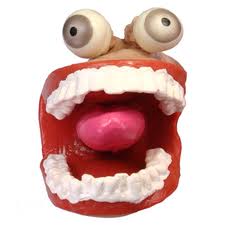Vertical section through a mature placenta. It consists of the chorionic plate (membrana chorii) 1 , the branched microvilli and the basal plate (not shown here). The intervillous space 2 with the maternal stream of blood is located between the villi. This micrograph shows the chorionic plate 1 (upper part of the figure), which is covered by a single-layered cuboidal to columnar amnion epithelium 3 (see Fig. 590). Syncytiotrophoblasts cover the chorionic plate at the intervillous space. Many termini of villi 4 and branches of villi underneath the chorionic plate are sectioned. They are covered with syncytiotrophoblasts as well (see Fig.587). Fibrinoid (Langhans) is present between villi and subchorionic tissue. Fibroid material is acidophilic.
Figure 585
Figure 585
Info :
1. Chorionic plate, membrana chorii
2. Intervillous space3. Amnion epithelium, fetal side of the placenta
4. Placental villi
5. Subchorionic fibrinoid
Stain: alum hematoxylin-eosin; magnification: × 40
Detail of the labyrinth from a human placenta (39 weeks of gestation) with multiple villi (overview). With the exception of a fewsporadic cells, the cytotrophoblast layer has degenerated. Therefore, the villi 1 are only surrounded by the syncytiotrophoblast. Darker proliferation nodes are seen in some places on the surface. The center part of the villi consists of loose chorionic mesodermal tissue and erythrocyte-filled capillaries. There are maternal blood cells in the intervillous space 2 (maternal milieu).
Figure 586
Figure 586
Info :
1. Placental villi
2. Intervillous space
Stain: Masson-Goldner trichrome; magnification: × 65
2. Intervillous space
Stain: Masson-Goldner trichrome; magnification: × 65
Cross-section of the chorionic villi from a human placenta in the 4th gestational month. The chorionic villi consist of loosely structured chorionic mesoderm 1 and a cover of ectodermal trophoblasts. Capillaries 2 and rounded, eosinophilic cells with granules or vacuoles (Hofbauer cells) are found in the chorionic mesoderm.Up to the end of the 4th gestational month, the trophoblast covering is two-layered. The inner epithelium with cytotrophoblasts (Langhans layer) 3 clearly shows the borders of the cuboidal cells. The outer layer consists of polynucleated cells with undefined borders. The intervillous space contains sporadic maternal blood cells and fibrin clots (cf. Figs. 585, 586, 588).
Figure 587
Figure 587
Info :
1. Mesenchymal villi stroma
2. Capillaries
3. Cytotrophoblast
4. Syncytiotrophoblast
Stain: azan; magnification: × 210
2. Capillaries
3. Cytotrophoblast
4. Syncytiotrophoblast
Stain: azan; magnification: × 210
Reference :
Kuehnel, Color Atlas of Cytology, Histology, and Microscopic Anatomy, 4th ed. 2003.
Continued...




















13 comments:
sometimes it's used for human skin, is it true?
@Ladida...hahaha...it's called "cabang bayi" in bahasa... XD
I dont understand ..
hahaha .. :)
@Deny Arya Wiranata ini udah yang paling simple loh.... T-T
if this is a tool that feeds the fetus? provide nutrients or food and oxygen to the fetus, also functions as a respirator for the fetus? as a means of removing the former metabolism?
@amPuzz hahaha...that's true...In addition the placenta can also be used as a stem cell (for transplatation)... :)
wahhh,,bahasanee kagak ngerti awak,,cuma ikutan comment aja :) gapapa kan kakk... ??
@Rheza Valerian gk apa2 mas bro... :D
@Ladida Oh...iya...gw lupa kalo ternyata placenta itu juga bisa buat skin care... :)
nah, that's I mean :D #lol
@Twins-X...no problemo...T-T
I don’t know how should I give you thanks! I am totally stunned by your article. You saved my time. Thanks a million for sharing this article.
Hi, Really great effort. Everyone must read this article. Thanks for sharing.
Posting Komentar